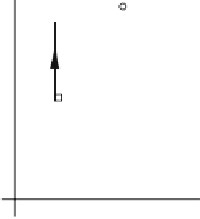Graphics Reference
In-Depth Information
Then the vector normal to the line is
=
+
n
a
i
b
j
Let T xy be a point on the line with position vector
t
=
x
i
+
y
j
. Therefore,
n
·
t
=
ax
+
by
=
c
(3.46)
Now
p
=
t
+
n
(3.47)
Using
n
, take the dot product of Eq. (3.47):
n
·
p
=
n
·
t
+
n
·
n
(3.48)
Substituting Eq. (3.46) in Eq. (3.48) gives
n
·
p
=
c
+
n
·
n
Therefore, we have
·
−
·
−
n
p
c
n
p
c
=
=
(3.49)
·
2
n
n
n
Now
q
=
p
−
2
n
Therefore,
2
n
n
·
p
−
c
q
=
p
−
(3.50)
2
n
If
n
is a unit vector
n
, then
ˆ
q
=
p
−
2
n
ˆ
·
p
−
c
n
ˆ
(3.51)
Before proceeding with the parametric form of the line equation, let's test Eq. (3.51) with a
simple example — one where we can predict the result.
Y
P(
1,2
)
n
=
j
y
=
1
1
X
Q
(
1,0
)
Figure 3.24.








